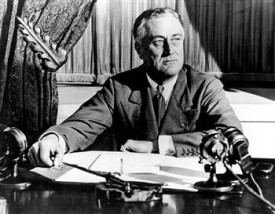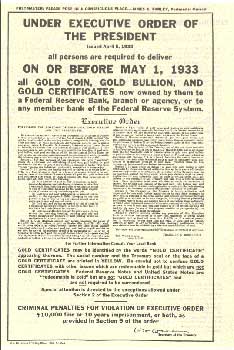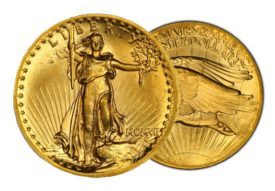 Gold confiscation is a subject that divides gold investors. Some say it won’t happen again and others say it will happen again. The one thing they tend to agree on is that they don’t want it to happen again.
Gold confiscation is a subject that divides gold investors. Some say it won’t happen again and others say it will happen again. The one thing they tend to agree on is that they don’t want it to happen again.
One factor that is sometimes quoted against a likelihood of government seizure of gold is the alleged fact that only a minority of American citizens turned in their gold after Roosevelt issued Executive Order 6102 in April 1933. If that were true, one may be led to believe that a confiscation decree is something that can be ignored since the government could not possibly enforce a nationwide search of all suspect households. Therefore, the deduction is that the government won’t bother resorting to such coercion.
This article is written to suggest that the following statement by the government of the time was not bluster but largely true:
“White House Statement on Returning Gold to Federal Reserve Banks. April 5, 1933
In the past weeks the country has given a remarkable demonstration of confidence. With the reopening of a majority of the banks of the country, currency in excess of $1,200,000,000, of which more than $600,000,000 was in the form of gold and gold certificates, has been returned to the Federal Reserve Banks.
Many persons throughout the United States have hastened to turn in gold in their possession as an expression of their faith in the Government and as a result of their desire to be helpful in the emergency. There are others, however, who have waited for the Government to issue a formal order for the return of gold in their possession. Such an order is being issued today.”
 The anti-confiscation contention is that the people who were waiting for the government to issue a formal order were not for turning their gold in. As can be seen from the above release, $600m or roughly the equivalent of 30 million ounces of gold in coin and certificate had been returned to the banks prior to the executive order.
The anti-confiscation contention is that the people who were waiting for the government to issue a formal order were not for turning their gold in. As can be seen from the above release, $600m or roughly the equivalent of 30 million ounces of gold in coin and certificate had been returned to the banks prior to the executive order.
Now it can be conceded that the people waiting for an official order may have ultimately held onto their gold, but a reading of the order suggests that illegally held gold was probably not going to happen in any great measure. The relevant section is this one:
“All persons are hereby required to deliver on or before May 1, 1933, to a Federal Reserve bank or a branch or agency thereof or to any member bank of the Federal Reserve System all gold coin, gold bullion, and gold certificates now owned by them or coming into their ownership on or before April 28, 1933, except the following:
(b) Gold coin and gold certificates in an amount not exceeding in the aggregate $100.00 belonging to any one person; and gold coins having recognized special value to collectors of rare and unusual coins.”
Now section (b) is the text of interest. Many have focussed on the numismatical portion, but I have rarely seen much said about the $100 exemption clause. At that time gold was valued at $20 per ounce. The $20 double eagle coin in circulation contained just under an ounce of gold and five of them made up $100.
 What is this exemption clause in executive order 6102 saying? It is saying that each person could keep up to five ounces of gold coin in their possession without fear of prosecution! At that time, the adult population of America was about 90 million. In theory, the population could have held onto 450 million ounces of gold if they had the means and will to do it (in practise, this much gold was never minted into coin).
What is this exemption clause in executive order 6102 saying? It is saying that each person could keep up to five ounces of gold coin in their possession without fear of prosecution! At that time, the adult population of America was about 90 million. In theory, the population could have held onto 450 million ounces of gold if they had the means and will to do it (in practise, this much gold was never minted into coin).
Now the reason I was motivated to write this was an article I saw by the respected gold analyst, James Turk. In that article he argues that there was a widespread illegal hoarding of gold by US citizens. To prove this, he cites Milton Friedman and Anna Schwartz in their book, “A Monetary History of the United States, 1867-1960“.
In that book, statistics are given which suggest that 13.9 million ounces of gold were still in circulation in January 1934 and that only about 21.9% of the gold in circulation had been handed in.
The trouble with this statement is that it does not seem to take this 5-ounce exemption clause into account. Although we do not believe that 90 million people actually held 5 ounces each, it would only take each adult in America to legally hold 0.15oz of gold to account for this “missing” 13.9 million ounces. Indeed, even if an attempt was made to take this 5oz exemption into account, I would consider it nigh impossible to differentiate legally held coin from illegally held coin.
How much of these 13.9 million ounces was legally held? Of course, we cannot say definitely, but it seems clear to me that even during the Great Depression, holding five ounces of gold was not an onerous task for many. How much was the average wage in America in 1933? I found a few answers by searching the Internet, but they averaged out at about $1400 per annum. That means that $100 was less than a month’s wage and although the savings rate in 1933 was one of the lowest in recent American history, we suspect many households held more than $100 in savings.
Indeed, it would only take 2.8 million adults or 3% of the adult population to hold 5oz and account for the entire 13.9 million ounces of gold. When we also consider how many probably redistributed their excess gold coins to wives, sons, daughters, parents and so on to avoid confiscation, I think we can safely conclude that illegal hoarding was not a major activity.
Now one may say that if Roosevelt had not included this 5oz exemption then illegal hoarding would have happened. Perhaps it would have but in this threshold rule we see Roosevelt the Socialist in action. For you see, democratic socialism has this thing about progressive taxation and confiscation. Just as people will not start paying tax on their income until they have crossed their personal “allowance”, so it was with this gold clause. How do you get the majority of average income voters on your side on this matter? You simply let them keep a portion of their gold and then give them the added bonus of a 57% windfall when gold is revalued to $35!
So how would this arrested form of confiscation work if it was imposed today? As it happens, five ounces of gold currently costs about $2,800. If the average American wage is $40,000 today, then this 5oz would form 7% of annual income. In 1933, it would have been 7% ($100 into $1400). Who said gold was not a good store of wealth?
NOTE: This article was originally published on March 27, 2006. As of this date (June 2, 2024) an ounce of Spot gold is approximately $2, 330.00 per ounce with an estimated retail value of about $2,416.00. ~ Editor
When (not if) confiscation comes back to shore up the Western nations’ failing fiat reserves, would we see something like the 5oz exemption clause come back? I would say so, but then again government may assume that individuals hold so little gold today that such a clause would have no use.
It is a subject I commend to all gold investors as we watch the present fiat-based economy continue to march towards catastrophe in the years ahead.
Written by Roland Watson for 24h GOLD March 27, 2006.
 FAIR USE NOTICE: This site contains copyrighted material the use of which has not always been specifically authorized by the copyright owner. We are making such material available in our efforts to advance understanding of environmental, political, human rights, economic, democracy, scientific, and social justice issues, etc. We believe this constitutes a ‘fair use’ of any such copyrighted material as provided for in section 107 of the US Copyright Law. In accordance with Title 17 U. S. C. Section 107, the material on this site is distributed without profit to those who have expressed a prior interest in receiving the included information for research and educational purposes. For more information go to: http://www.law.cornell.edu/uscode/17/107.shtml
FAIR USE NOTICE: This site contains copyrighted material the use of which has not always been specifically authorized by the copyright owner. We are making such material available in our efforts to advance understanding of environmental, political, human rights, economic, democracy, scientific, and social justice issues, etc. We believe this constitutes a ‘fair use’ of any such copyrighted material as provided for in section 107 of the US Copyright Law. In accordance with Title 17 U. S. C. Section 107, the material on this site is distributed without profit to those who have expressed a prior interest in receiving the included information for research and educational purposes. For more information go to: http://www.law.cornell.edu/uscode/17/107.shtml








